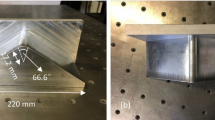Abstract
Methods are proposed for an integral (generalized) evaluation of the degree of ordering of the structure and defectiveness of fibres based on the inverse use of indexes of their mechanical properties — modulus of elasticity and strength — normalized with respect to their maximum attainable values. These maximum attainable values are determined in defined temperature-time conditions for a defect-free polymer crystal by several methods, obtaining values in relatively good agreement. The coefficients characterizing the overall ordering and imperfection of the structure, and the defectiveness of different types of fibres based on linear (aliphatic and aromatic), laminar (carbon), and three-dimensional (silicate) polymers were estimated. Different types of fibres, including fibres of the same type, were compared with respect to the level of structural organization and defectiveness. This could serve as a measure of the perfection of the fabrication processes.
Similar content being viewed by others
References
K. E. Perepelkin, Structure and Properties of Fibres [in Russian], Khimiya, Moscow (1985).
M. Jambrich, A. Pikler, and I. Diacik, Fizika Vlaken, Alfa, Bratislava (1988).
M. Tadocoro, Structure of Crystalline Polymers, Interscience, New York (1979).
K. E. Perepelkin, Tekst. Khim., No. 1, 9–19: No. 2 16–27, (1992).
K. E. Perepelkin, Mekh. Kompozitn. Mater., No. 3, 387–395 (1987).
K. E. Perepelkin, Mekh. Kompozitn. Mater., No. 3, 291–306 (1992).
V. S. Smirnov, K. E. Perepelkin and L. I. Fridman (eds.) New Chemical Fibres for Technical Applications [in Russian], Khimiya, Moscow (1973).
G. M. Bartenev, Superstrong and High-Strength Inorganics Fibres [in Russian], Stroiizdat, Moscow (1974).
K. E. Perepelkin, Mekh. Polim., No. 1, 34–42 (1966).
K. E. Perepelkin, Mekh. Polim., No. 6, 845–856 (1966).
K. E. Perepelkin, Khim. Volokna, No. 2, 3–13 (1966).
K. E. Perepelkin, Bolgarska Akad. Na Naukita, Izv. Khim.,23, No. 3, 447–456 (1990).
K. E. Perepelkin, Fiz.-Khim. Mekh. Mater., No. 2, 74–78 (1972).
K. E. Perepelkin and Z. Yu. Chereiskii, Mekh. Polim., No. 6, 1002–1010 (1977).
K. E. Perepelkin, Fiz.-Khim. Mekh. Mater., No. 2, 78–80 (1970).
G. M. Bartenev, Strength and Mechanism of Failure of Polymers [in Russian], Khimiya, Moscow (1984).
L. I. Slutsker, L. E. Utevski, et al., J. Polym. Sci., Polym. Symp., No. 58, 339–358 (1971).
L. P. Zosin, A. P. Verkhovets, et al., Mekh. Kompozitn. Mater., No. 3, 391–394 (1983).
W. Zurek, W. Calka, and J. Jakubczyk, Fibre Sci. Technol.,20, 199–209 (1984).
V. Kacvinsky, Chem. Vlakna,37, No. 3, 207–217 (1987).
K. E. Perepelkin, in: Carbochain Synthetic Fibres [in Russian], K. E. Perepelkin (ed.), Khimiya, Moscow (1973), pp. 165–355.
K. Riggert, Chemiefasern,21, No. 6, 379–386 (1971).
K. E. Perepelkin, in: Encyclopedia of Polymers, [in Russian], Vol. 3, Sov. Entsiklopediya, Moscow (1977), pp. 234–238.
K. E. Perepelkin, in: Encyclopedia of Chemistry [in Russian], Vol. 1, Sov. Entsiklopediya, Moscow (1988), pp. 413–416.
L. V. Avrorova, A. V. Volokhina, et al., Khim. Volokna, No. 4, 21–26 (1989).
G. A. Budnitskii, Khim. Volokna, No. 2, 5–13 (1990).
G. I. Kudryavtsev, V. Ya. Varshavskii, et al., Reinforcing Chemical Fibres for Composite Materials, [in Russian], Khimiya, Moscow (1992).
V. V. Vasil'ev (ed.), Handbook of Composite Materials [in Russian], Mashinostroenie, Moscow (1990).
E. A. Pfitzer (ed.), Carbon Fibres and Carbon Composites [in Russian], Mir, Moscow (1988).
R. M. Levit, Conducting Chemical Fibres [in Russian], Khimiya, Moscow (1986).
M. S. Aslanova, Glass Fibres [in Russian], Khimiya, Moscow (1979).
V. I. Kiselev, in: Encyclopedia of Chemistry [in Russian], Vol. 4, Bol'shaya Ross. Entsiklopediya, Moscow (1995), pp. 427–428.
V. S. Kuksenko, V. A. Ovchinnikov, and A. I. Slutsker, Vysokomolek. Soedin., Ser. A, No. 9, 1953–1957 (1969).
Additional information
St. Petersburg State University of Technology and Design. Translated from Khimicheskie Volokana, No. 5, pp. 34–41 September–October, 1996.
Rights and permissions
About this article
Cite this article
Perepelkin, K.E. Inverse evaluation of the integral ordering of the structure and defectiveness of fibres and yarns for technical applications based on normalized values of the mechanical properties. Fibre Chem 28, 326–335 (1996). https://doi.org/10.1007/BF01057699
Issue Date:
DOI: https://doi.org/10.1007/BF01057699




